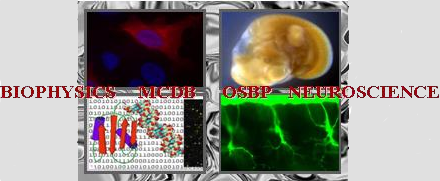Poster abstracts
Poster number 102 submitted by David Bowles
Modifying the stability of tumor suppressor p53 through S7-S8 loop mutagenesis and NMR studies of the pheromone Er-23
David Bowles (OSBP), David Rabinovich (Undergraduate), Sidharth Mohan (Biophysics), Calvin Rhoads (Undergraduate)
Abstract:
The tumor suppressor p53 is a critical 54 kDa protein responsible for the regulation of cellular differentiation during times of cellular stress. This protein is so critical is to be found to be mutated in approximately 50% of all human cancer cases. The majority of these mutations are found in the central, ordered DNA-binding domain of the protein. One way in which these mutations can disrupt DNA binding is to lower the overall stability of the protein, making it unable to properly interact with DNA. Consequently, any knowledge that can be gained in stabilizing the p53 DNA-binding domain could potentially be very valuable. It has been observed that the p53 homolog in C. elegans is considerably more stable than its human counterpart. By comparing the sequences of human p53 and worm p53, it was proposed that shortening the S7S8 turn is an important factor in this stability. This initial work was done in silico, and the Magliery lab is constructing mutants based on this hypothesis to be expressed and screened in vitro. By expressing and screening various four- and five- residue deletion mutants, insight was gained into which residues are important in the loop. These results will be used to design a loop mutant library that will probe sequence space for mutants that are more stable than the control construct. In addition to the worm p53 comparison strategy, algorithmic improvement of p53 has been attempted using methodology developing in the Magliery lab. The resulting construct is algorithm derived p53, or Algo p53, has been expressed and characterized. As a prelude to p53/CEP-1 NMR work, NMR work on a smaller protein has been started. Our lab has produced the pheromone ER-23 from E. coli cells, previously thought not viable. This allowed us to produce an N-15/C-13 labeled version from which to determine an NMR solution structure with more constraints than the natural abundance only structure in the literature.
Keywords: protein engineering, NMR, protein loops
